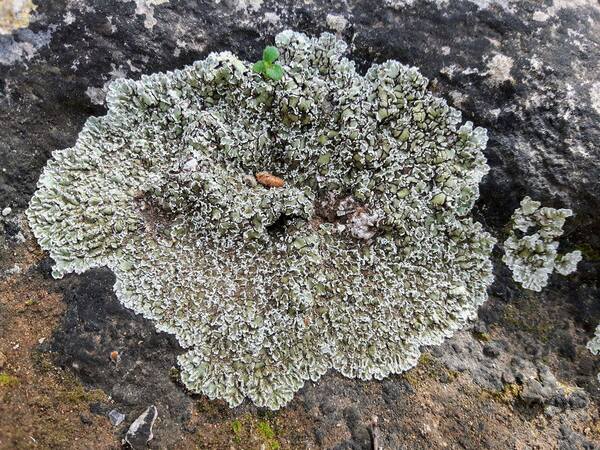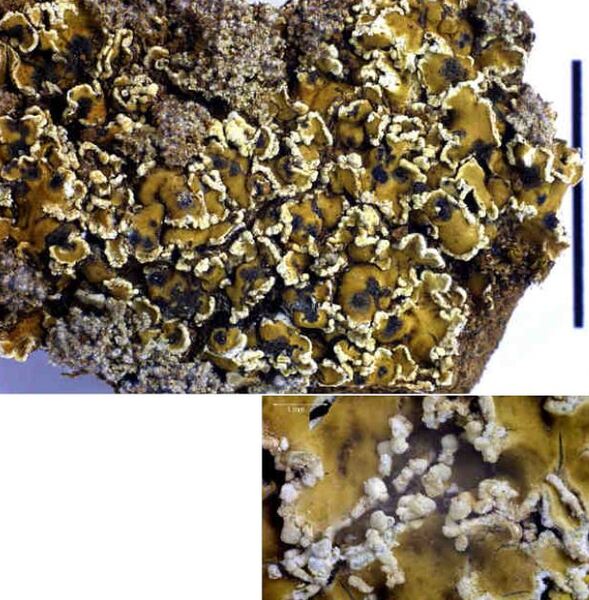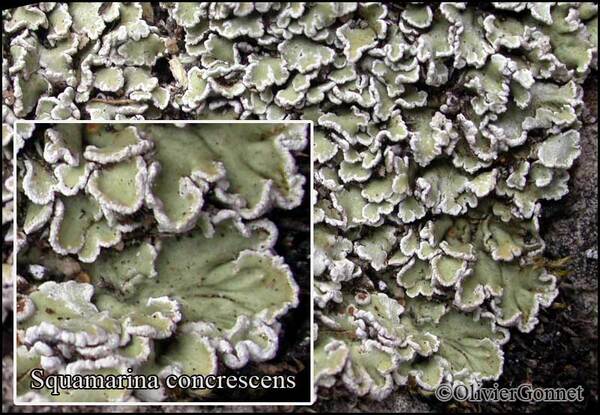Squamarina concrescens (Müll. Arg.) Poelt
Mitt. bot. Staatss. München, 2: 532, 1958. Basionym: Placodium concrescens Müll. Arg. - Bull. Herb. Boissier, 1: 130, 1893.
Synonyms: Lecanora sublentigera Jatta; Squamarina concrescens subsp. cravensis (Clauzade & Cl. Roux) Clauzade & Cl. Roux?; Squamarina concrescens var. cravensis Clauzade & Cl. Roux?
Distribution: N - Lig. C - Tosc (TSB 35301), Laz (Nimis & Tretiach 2004), Abr (Nimis & Tretiach 1999), Sar. S - Camp (Nimis & Tretiach 2004, Garofalo & al. 2010), Pugl (Nimis & Tretiach 1999, Gianfreda & Matino 2020), Cal (Nimis & Puntillo 2003, Puntillo 2011), Si (Nimis & al. 1994, Ottonello & al. 2011).
Description: Thallus squamulose to subcrustose-placodioid, thick, greenish white to yellowish green, forming orbicular to irregular up to 8 cm wide rosettes. Central parts of thallus areolate-squamulose; marginal lobes radiating, concave with raised margins, 3-5 mm wide, contiguous to rarely overlapping, smooth to wrinkled, with dense, marginal, 0.3-1 mm wide, flattened and basally constricted, fragile, white isidia-like lobules. Upper cortex paraplectenchymatous, 30-40 µm thick; medulla chalky white, very thick. Apothecia rare, lecanorine to zeorine, up to 3-4 mm across, with a concave to flat, smooth, pale ochre-coloured to greenish brown disc, and a variably thick, finally often excluded thalline margin. Epithecium brownish; hymenium colourless, 60-70 µm high, I+ blue; paraphyses slightly swollen at apex; hypothecium colourless. Asci 8-spored, clavate to cylindrical-clavate, the apical dome K/I+ dark blue, the wall I-, but the thin outer gel I+ blue, Bacidia-type. Ascospores often poorly developed, 1-celled, hyaline, ellipsoid (7.5)10-12.5(-15) x 4-6 µm. Photobiont chlorococcoid. Spot tests: thallus K-, C-, KC- or KC+ yellowish, P-; medulla and ‘isidia’ P+ deep yellow or P-. Chemistry: cortex with usnic acid; medulla with or without psoromic acid.Note: an often misunderstood species, with a southern distribution centred in dry areas, found on base-rich clay soil in clearings of grasslands and garrigues, but also on weathered or fissured rocks; mostly Tyrrhenian in Italy.
Growth form: Crustose placodiomorph
Substrata: rocks, soil, terricolous mosses, and plant debris
Photobiont: green algae other than Trentepohlia
Reproductive strategy: mainly asexual, by isidia, or isidia-like structures (e.g. schizidia)
Commonnes-rarity: (info)
Alpine belt: absent
Subalpine belt: absent
Oromediterranean belt: absent
Montane belt: absent
Submediterranean belt: very rare
Padanian area: absent
Humid submediterranean belt: rather rare
Humid mediterranean belt: rare
Dry mediterranean belt: very rare
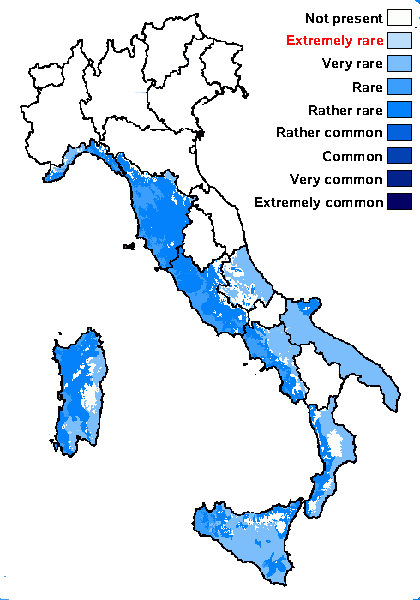
Predictive model
Herbarium samples
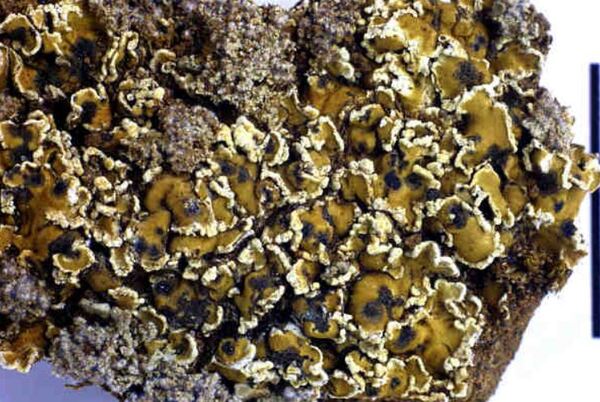

Felix Schumm - CC BY-SA 4.0; Owner: Image from: F. Schumm (2008) - Flechten Madeiras, der Kanaren und Azoren. Beck, OHG - ISBN: 978-3-00-023700-3
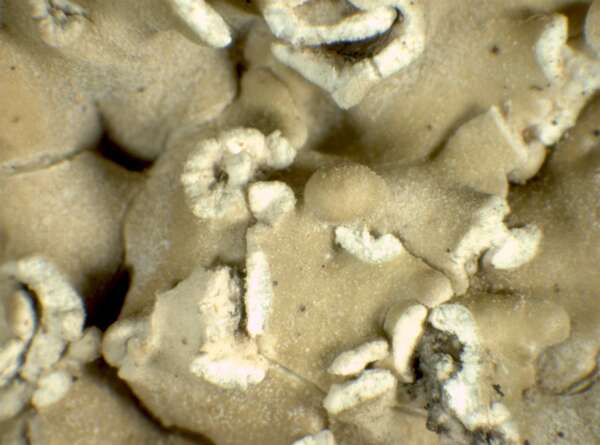

P.L. Nimis; Owner: Department of Life Sciences, University of Trieste
Herbarium: TSB (18650)
2001/12/11
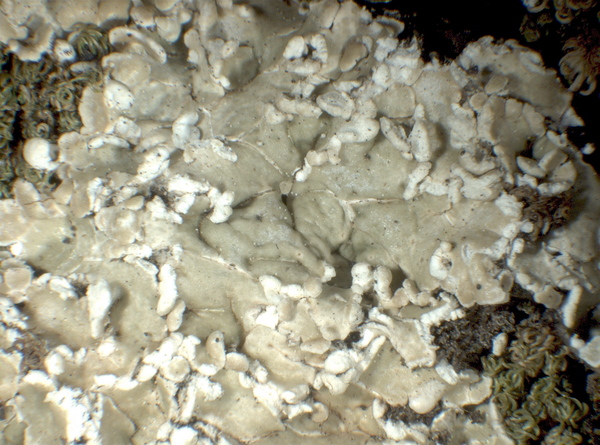

P.L.Nimis; Owner: Department of Life Sciences, University of Trieste
Herbarium: TSB (38359)
2008.02.25
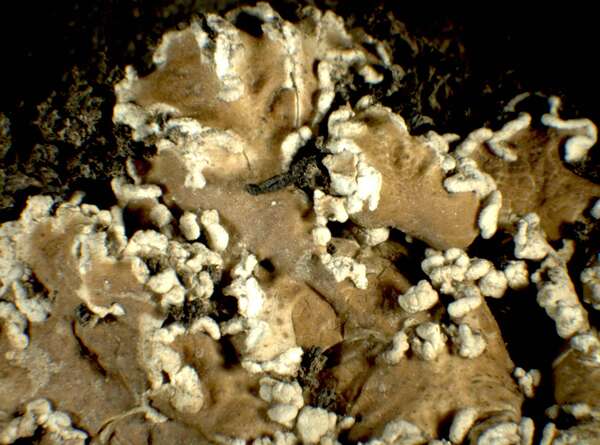

P.L. Nimis; Owner: Department of Life Sciences, University of Trieste
Herbarium: TSB (13803)
2001/12/11
Growth form: Crustose placodiomorph
Substrata: rocks, soil, terricolous mosses, and plant debris
Photobiont: green algae other than Trentepohlia
Reproductive strategy: mainly asexual, by isidia, or isidia-like structures (e.g. schizidia)
Commonnes-rarity: (info)
Alpine belt: absent
Subalpine belt: absent
Oromediterranean belt: absent
Montane belt: absent
Submediterranean belt: very rare
Padanian area: absent
Humid submediterranean belt: rather rare
Humid mediterranean belt: rare
Dry mediterranean belt: very rare

Predictive model
| Herbarium samples |


Felix Schumm - CC BY-SA 4.0; Owner: Image from: F. Schumm (2008) - Flechten Madeiras, der Kanaren und Azoren. Beck, OHG - ISBN: 978-3-00-023700-3


P.L. Nimis; Owner: Department of Life Sciences, University of Trieste
Herbarium: TSB (18650)
2001/12/11


P.L.Nimis; Owner: Department of Life Sciences, University of Trieste
Herbarium: TSB (38359)
2008.02.25


 Index Fungorum
Index Fungorum
 GBIF
GBIF
